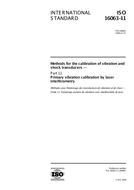We need your consent to use the individual data so that you can see information about your interests, among other things. Click "OK" to give your consent.

ISO 16063-11:1999
Methods for the calibration of vibration and shock transducers — Part 11: Primary vibration calibration by laser interferometry
Automatically translated name:
Methods for the calibration of vibration and shock transducers -- Part 11: Primary vibration calibration by laser interferometry
STANDARD published on 16.12.1999
The information about the standard:
Designation standards: ISO 16063-11:1999
Publication date standards: 16.12.1999
SKU: NS-426837
The number of pages: 27
Approximate weight : 81 g (0.18 lbs)
Country: International technical standard
Category: Technical standards ISO
The category - similar standards:
Annotation of standard text ISO 16063-11:1999 :
Description / Abstract: This part of ISO 16063 specifies the instrumentation and procedure to be used for primary vibration calibration of rectilinear accelerometers (with or without amplifier) to obtain magnitude and phase lag of the complex sensitivity by steady-state sinusoidal vibration and laser interferometry. It is applicable to a frequency range from 1 Hz to 10 kHz and a dynamic range (amplitude) from 0,1 m/s2 to 1 000 m/s2 (frequency-dependent). These ranges are covered with the uncertainty of measurement specified in clause 2. Calibration frequencies lower than 1 Hz (e.g. 0,4 Hz, which is a reference frequency used in other International Standards) and acceleration amplitudes smaller than 0,1 m/s2 (e.g. 0,004 m/s2 at 1 Hz) can be achieved using Method 3 specified in this part of ISO 16063, in conjunction with an appropriate low-frequency vibration generator. Method 1 (fringe-counting method) is applicable to sensitivity magnitude calibration in the frequency range 1 Hz to 800 Hz and, under special conditions, at higher frequencies (cf. clause 7). Method 2 (minimum-point method) can be used for sensitivity magnitude calibration in the frequency range 800 Hz to 10 kHz (cf. clause 8). Method 3 (sine-approximation method) can be used for magnitude of sensitivity and phase calibration in the frequency range 1 Hz to 10 kHz (cf. clause 9). Methods 1 and 3 provide for calibrations at fixed acceleration amplitudes at various frequencies. Method 2 requires calibrations at fixed displacement amplitudes (acceleration amplitude varies with frequency).
We recommend:
Technical standards updating
Do you want to make sure you use only the valid technical standards?
We can offer you a solution which will provide you a monthly overview concerning the updating of standards which you use.
Would you like to know more? Look at this page.



 Cookies
Cookies
